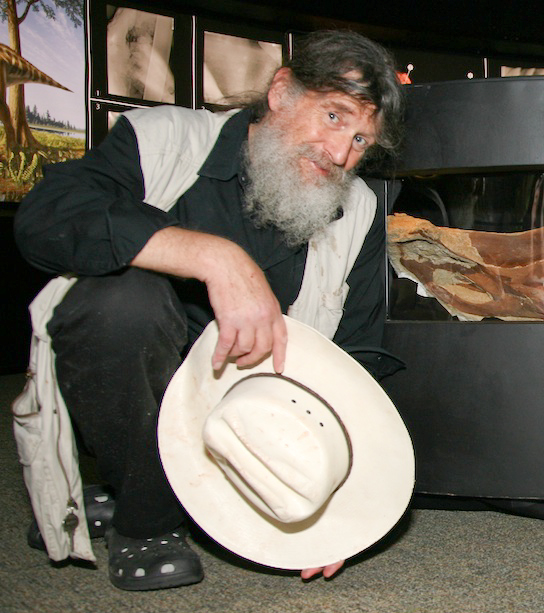The Dinosaur Heresies: A Revolutionary View of Dinosaurs (1986), Longman Scientific & Technical, p. 20
The Dinosaur Heresies (1986)
Robert Bakker: Cytaty po angielsku
Perhaps they were not.
"Dinosaur Renaissance", Scientific American 232, no. 4 (April 1975), 58—78
Dinosaur Renaissance (1975)
"The Superiority of Dinosaurs", Discovery 3(2),(1968) 11–22
The Superiority of Dinosaurs (1968)
or most powerful defensive weapons - the approach taken by Triceratops.
The Dinosaur Heresies: A Revolutionary View of Dinosaurs (1986), Longman Scientific & Technical, p. 240-241
The Dinosaur Heresies (1986)
The Dinosaur Heresies: A Revolutionary View of Dinosaurs (1986), Longman Scientific & Technical, p. 160-161
The Dinosaur Heresies (1986)
The Dinosaur Heresies: A Revolutionary View of Dinosaurs (1986), Longman Scientific & Technical, p. 81
The Dinosaur Heresies (1986)
The Dinosaur Heresies: A Revolutionary View of Dinosaurs (1986), Longman Scientific & Technical, p. 17
The Dinosaur Heresies (1986)
"Dinosaur Renaissance", Scientific American 232, no. 4 (April 1975), 58—78
Dinosaur Renaissance (1975)
"Dinosaur Renaissance", Scientific American 232, no. 4 (April 1975), 58—78
Dinosaur Renaissance (1975)
The Dinosaur Heresies: A Revolutionary View of Dinosaurs (1986), Longman Scientific & Technical, p. 57
The Dinosaur Heresies (1986)
As quoted in Dr. Robert Bakker Answers Your Questions http://science.slashdot.org/story/13/03/10/2217251/dr-robert-bakker-answers-your-questions, science.slashdot.org, (March 11, 2013)
The Dinosaur Heresies: A Revolutionary View of Dinosaurs (1986), Longman Scientific & Technical, p. 22-23
The Dinosaur Heresies (1986)
The Dinosaur Heresies: A Revolutionary View of Dinosaurs (1986), Longman Scientific & Technical, p. 165
The Dinosaur Heresies (1986)
The Dinosaur Heresies: A Revolutionary View of Dinosaurs (1986), Longman Scientific & Technical, p. 127
The Dinosaur Heresies (1986)
The Dinosaur Heresies: A Revolutionary View of Dinosaurs (1986), Longman Scientific & Technical, p. 16
The Dinosaur Heresies (1986)
The Dinosaur Heresies: A Revolutionary View of Dinosaurs (1986), Longman Scientific & Technical, p. 136-137
The Dinosaur Heresies (1986)
The Dinosaur Heresies: A Revolutionary View of Dinosaurs (1986), Longman Scientific & Technical, p. 153
The Dinosaur Heresies (1986)
As quoted in Malcolm W. Browne, Scientist Raises Question: Is Tyrannosaurus Still Rex? http://www.nytimes.com/1990/01/04/us/scientist-raises-question-is-tyrannosaurus-still-rex.html, The New York Times (January 4, 1990)
The Dinosaur Heresies: A Revolutionary View of Dinosaurs (1986), Longman Scientific & Technical, p. 154-155
The Dinosaur Heresies (1986)
The Dinosaur Heresies: A Revolutionary View of Dinosaurs (1986), Longman Scientific & Technical, p. 27
The Dinosaur Heresies (1986)
As quoted in Paleontological Profiles: Robert Bakker http://scienceblogs.com/laelaps/2008/04/07/paleontological-profiles-rober/, scienceblogs (April 7, 2008)
The Dinosaur Heresies: A Revolutionary View of Dinosaurs (1986), Longman Scientific & Technical, p. 68
The Dinosaur Heresies (1986)
“I do not believe birds deserve to be put in a taxonomic class separate from dinosaurs.”
"Dinosaur Renaissance", Scientific American 232, no. 4 (April 1975), 58—78
Dinosaur Renaissance (1975)
The Dinosaur Heresies: A Revolutionary View of Dinosaurs (1986), Longman Scientific & Technical, p. 62-63
The Dinosaur Heresies (1986)
“Dinosaurs Acting Like Birds, and Vice Versa – An Homage to the Reverend Edward Hitchcock, First Director of the Massachusetts Geological Survey” in Feathered Dragons. Currie, P.; Koppelhus, E.; Shugar, M.; Wright J. eds. 2004. Bloomington: Indiana University Press. pp. 1-11.
lizards, snakes, and turtles.
The Dinosaur Heresies: A Revolutionary View of Dinosaurs (1986), Longman Scientific & Technical, p. 127
The Dinosaur Heresies (1986)
The Dinosaur Heresies: A Revolutionary View of Dinosaurs (1986), Longman Scientific & Technical, p. 179
The Dinosaur Heresies (1986)
"Dinosaur Renaissance", Scientific American 232, no. 4 (April 1975), 58—78
Dinosaur Renaissance (1975)
The Dinosaur Heresies: A Revolutionary View of Dinosaurs (1986), Longman Scientific & Technical, p. 101
The Dinosaur Heresies (1986)
"Dinosaur Renaissance", Scientific American 232, no. 4 (April 1975), 58—78
Dinosaur Renaissance (1975)
